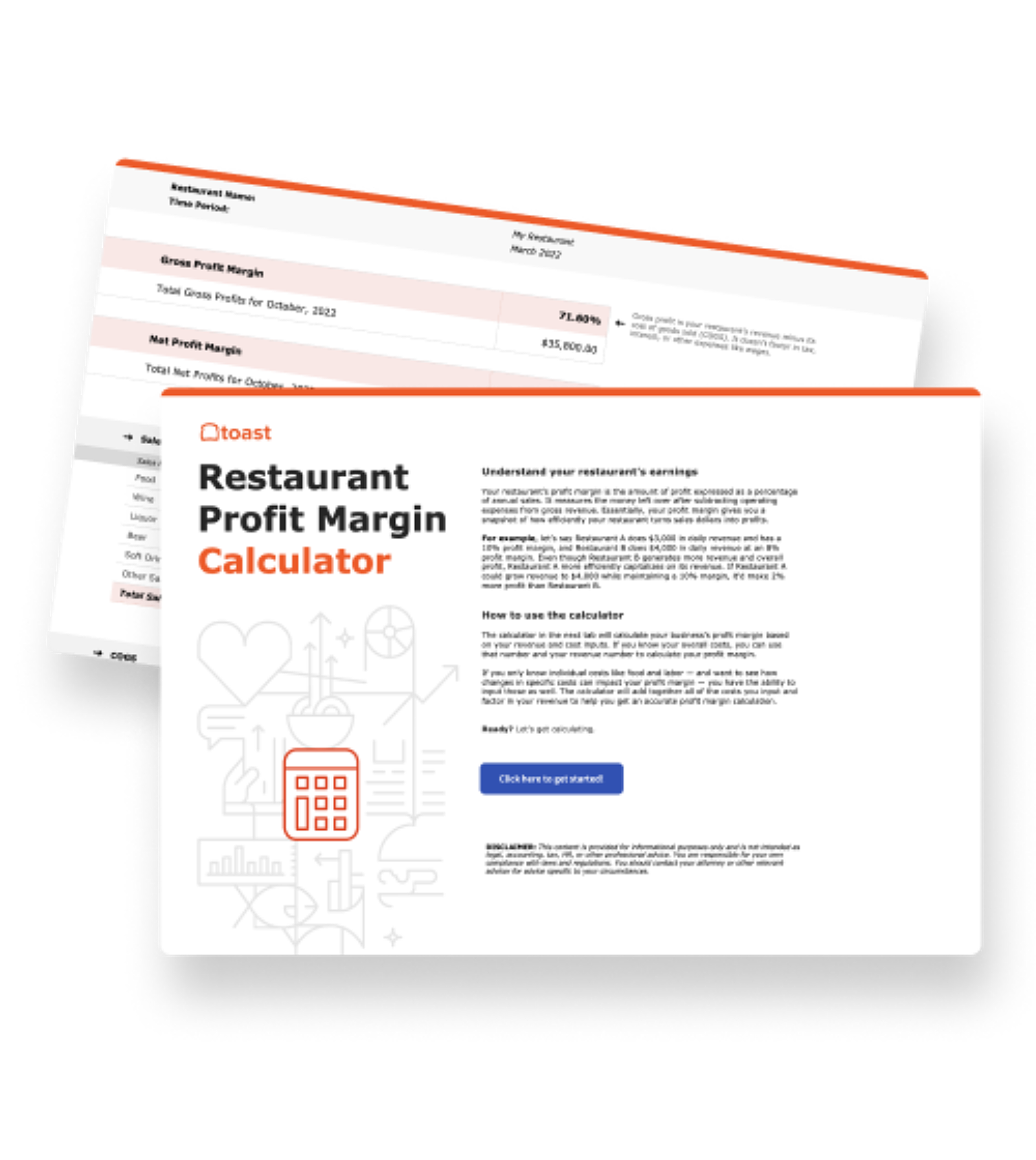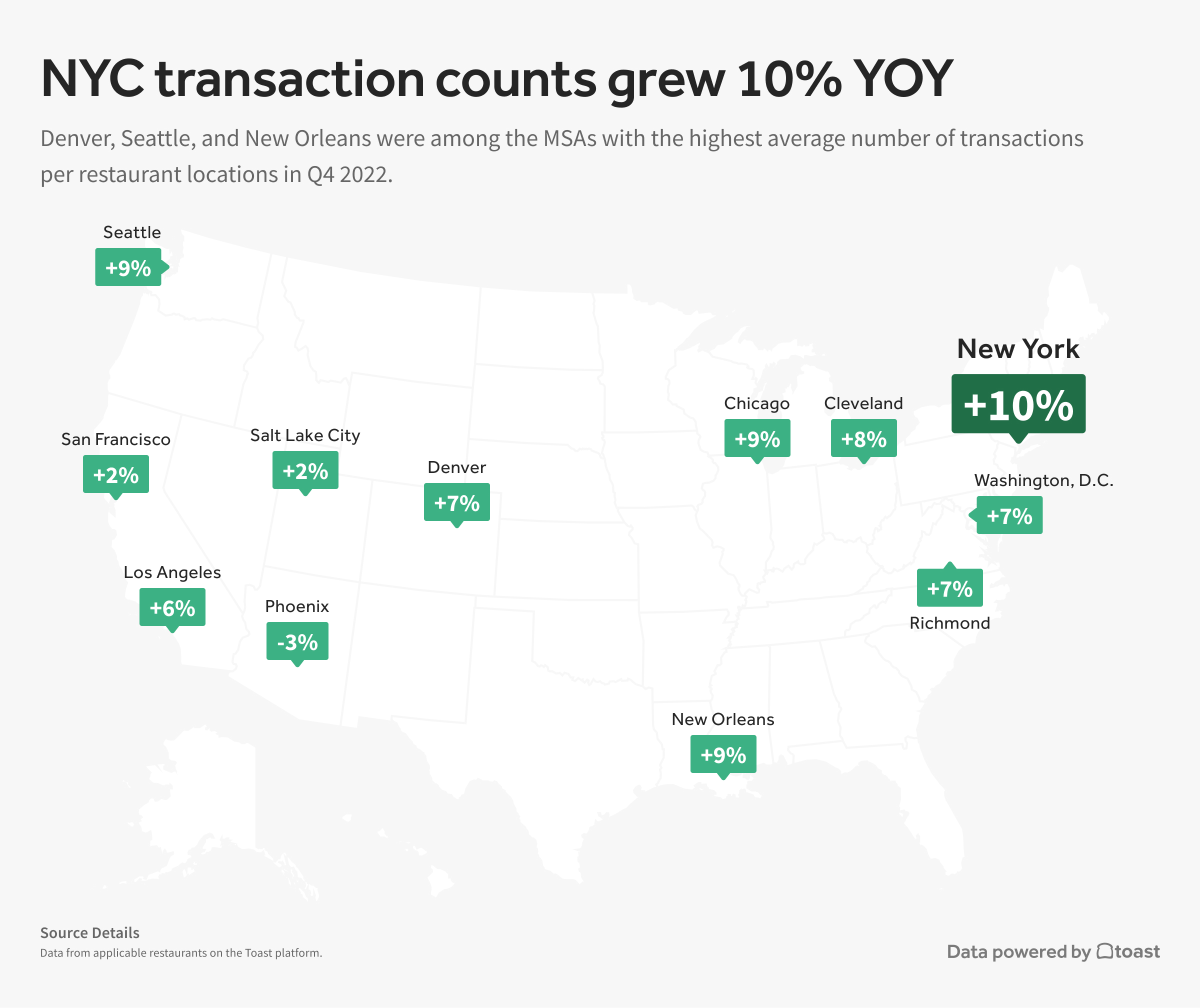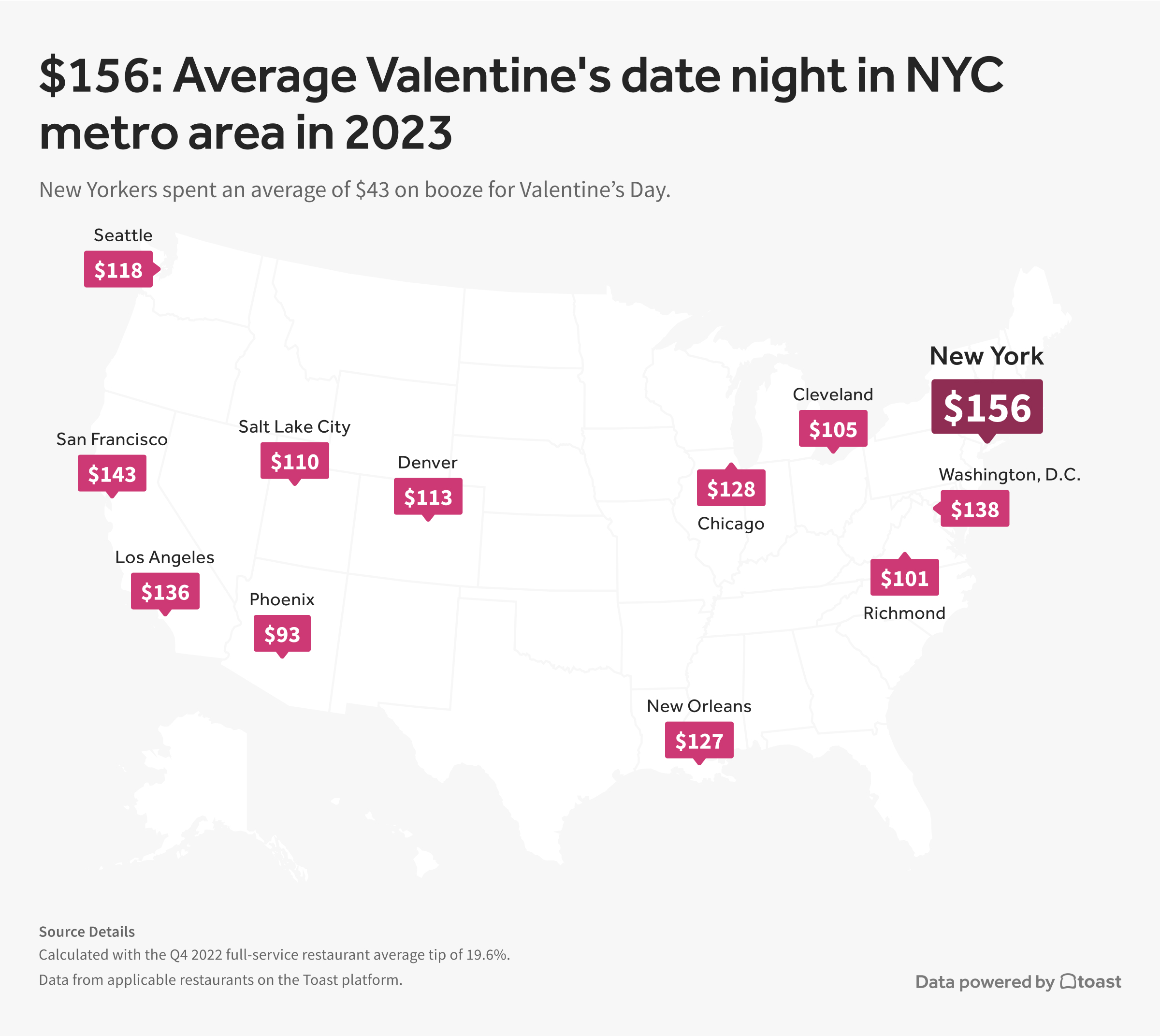
How Restaurants Can Navigate Food Inflation and Protect Profitability
Put rising food inflation into historical context and uncover action items to help protect profits and remain agile in the face of sustained economic pressure.

Justin GuinnAuthor


Restaurant Profit Margin Calculator
Use this free Restaurant Profit Margin Calculator to see how efficiently you turn sales dollars into profits.
Get free downloadTimes are tough — there’s no easy way around it.
Food inflation continues to drive ingredient prices higher. Wages remain elevated, and that's if restaurants can even hire new staff.
These headwinds can easily eat away restaurant profitability if operators don’t act.
While there’s no “solving” for food inflation, the negative impacts can be mitigated and margins protected. Operators have multiple means of riding out this wave of high inflation without sacrificing profitability.
Keep reading to learn more about the current food inflation and its impact on restaurants to date. See what’s happened in past inflationary environments, and get a few ideas for how to limit the negative impacts of inflation.
Key takeaways
- March 2023 CPI for food away from home (restaurants) is at 8.8 percent YoY — up 0.6 percent MoM for the third month in a row
- March 2023 CPI for food at home (groceries) dropped to 8.4 percent YoY— down 0.3 percent MoM, its first MoM decline since September 2020
- The Gasoline index fell 4.6 percent from February to March 2023 — down 17.4 percent YoY (unadjusted), highly favorable given the impact of gas prices on consumer restaurant spending
- Past inflationary and recession environments show that customers trade down rather than out of restaurant spending — and it's already happening
- Operators can capture the trade down and help protect profitability by optimizing sales channels and controlling costs
Restaurant Cost Control Guide
Use this guide to learn more about your restaurant costs, how to track them, and steps you can take to help maximize your profitability.

Historic food inflation poses risks to restaurant profitability
What is food inflation?
Whether you’re new to it or need a quick refresh: Inflation is an economic measure of the increase in price of a set of goods and services over a given period of time.
Food inflation is simply confined to increases in price for goods and services tied to food.
Restaurants and consumers are dealing with historic food inflation
There are a few ways economists track food inflation. All are measuring at or near all-time highs.
Food inflation via Consumer Price Index
The Consumer Price index (CPI) measures the average change over time in the prices paid by urban consumers for specific consumer goods and services.
The food index, including grocery, restaurants, and other food services, was flat month-over-month, holding at 8.5 percent YoY for March 2022 - 2023 — the same YoY measure as February.

Source: U.S. Bureau of Labor Statistics
The Bureau of Labor Statistic's CPI for food away from home is at 8.8 percent from March 2022 to 2023.

Source: U.S. Bureau of Labor Statistics
The March index for full-service meals increased 0.7 percent over the month to 8 percent YoY. The index for limited-service meals increased 0.5 percent from the prior month, to 7.9 percent YoY for March 2023.
Food inflation via Producer Price Index
The Producer Price Index (PPI) tracks the average change over time in selling prices received by domestic producers of goods and services from their perspective as the seller.

Source: U.S. Bureau of Labor Statistics
The PPI for all foods fell 5 percent YoY from January to February 2023 — from 11.3 percent to 6.3 percent.
Food inflation impacts and risks for restaurants
Consumer expectations continues improving
The University of Michigan Surveys of Consumers provides a snapshot on consumer sentiment across the U.S.
"Consumer sentiment confirmed the preliminary February reading, rising a modest 3% above January. After lifting for the third consecutive month, sentiment is now 17 index points above the all-time low from June 2022 but remains almost 20 points below its historical average." — Joanne Hsu, Surveys of Consumers Director, University of Michigan
The reality is that consumers are still climbing out of the crater of summer 2022 — but consistent increases in sentiment and purchasing power are favorable for restaurant spending.
Regardless of consumer sentiment, the data shows that consumers rarely withdraw their restaurant spend entirely. They instead trade down to more cost-efficient, value-focused options.
Customers trade down rather than out during turbulent times
There’s a common thread in data from past inflationary times and prior recessions — consumers look to trade down to more value-based options rather than trade out of restaurants entirely.
May 2008 through July 2008 was the last time the average national gas prices rose above $4 per gallon, Technomic reports.
Comparing this span of higher gas prices year-over-year with 2007 shows a definite decline in limited- and full-service restaurant sales — with full-service restaurants getting hit nearly twice as hard as limited-service (falling 4.3 percent and 2.2 percent in 2008, respectively.)
Academic research that shows the growth rate during recessions in the limited-service sector is still considerably high (2.43 percent) compared to full-service operations (0.08 percent). The study is based on National Restaurant Association data spanning between 1970 and 2009, so it includes six defined recessions.
This research highlights consumer willingness to continue patronizing restaurants during inflationary periods and recessions. And the resilience of limited-service operations during these times highlights the consumer sentiment toward trading down rather than out.
According to commentary from Jana Zschieschang, CMO at Revenue Management Solutions, we’re well into the trade-down phase this time around:
“When the average check increases but basket size (the number of items per order) decreases, it is a strong indicator that consumers aren’t getting ready to tighten their belts — they already are. The market is volatile, but one thing is clear: we’re officially in a trading down environment.”
Restaurant Profit and Loss Statement Template
Evaluate your restaurant's financial strengths and weaknesses with the free P&L and income statement template.

Rising food inflation and gas prices are a restaurant perfect storm
Food inflation decreases profitability due to higher ingredient and labor costs paired with lower sales due to weakened consumer spending — and then there’s the impact of volatile fuel prices.
A report from foodservice research firm Technomic shows how every $0.50 increase in gas prices results in a "$68 billion impact on consumer spending." Plummeting gas prices over the past year are a significant positive for restaurant.
The top two mentions for cutbacks are limited-service and full-service restaurants, with 49 and 48 percent of respondents respectively.
A similar survey from Reuters and Ipsos found over half of Americans (54%) say rising gas prices most impact how they spend their money on meals at restaurants.
Here’s a breakdown of the most impacted consumer spending buckets due to rising fuel costs:
Restaurants - 54 percent
Entertainment - 49 percent
Home improvement - 47 percent
Vacations - 46 percent
Restaurant Opening Calculator
This calculator lays out some of the fundamental financial costs of opening a restaurant, so you can start planning and bring your dream restaurant to life.

Actions to protect your restaurant profits from food inflation
Food inflation doesn’t have to be the restaurant grim reaper. Current and past inflationary and recession data shows this.
And with the advances and availability of powerful restaurant management platforms, operators have tons of tactics and strategies at their disposal for protecting profitability.
Raising your restaurant prices
The obvious tactic is simply raising prices and shrinking portions.
Take a look at a very real life example of ongoing food inflation straight from the frontlines. Feedwell Kitchen & Bakery shared the staggering calculations driving their recent price increases:
Restaurants have been hammered with COVID and now food inflation. Simply breaking it down for customers and appealing to their empathy and sense of reason could be a great way to instill trust and build stronger customer relationships — all while easing any tension with the price increase.
Of course, any price increases should be part of a cohesive menu pricing strategy rather than a random price.
Maximize margins while capitalizing on trade downs
Any resilience in the restaurant space during inflationary times seems dependent on capturing the trade down — providing real value while maintaining great experiences.
Here are a few steps that can help capture trade downs without minimizing margins:
1. Determine where your restaurant fits in your local ecosystem.
What are the menu price comps for similar restaurants in your area?
If you’re already consistently lower than the rest, then you’re already positioned for trade downs — not to say you shouldn’t look to further optimize your menu for a long haul of turbulent times.
And if you’re the restaurant with consistently high prices relative to your peers, it may be time to add some value-based options to the menu.
2. Ideate on how to satisfy price points that have traditionally been beneath your target menu prices.
The idea of lowering menu prices during high food inflation seems backward. You probably should be raising menu prices if you haven’t already this year. That doesn’t mean you can’t lock in some trade-down market share with new items and prices.
This is where menu engineering and recipe costing both shine, helping you balance prices and target profit margins.
Recipe costing systems can show you down to the penny how much each serving of every recipe costs. And menu engineering folds those costs into consideration with pricing, menu design, and more.
This exercise can also help reduce the number of unique ingredients used across your menu — lowering how much on-hand inventory you need to operate.
3. Think strategically about all the specials and limited-time offers (LTOs) that you run across your operation — food, drink, dine-in, takeout, all of them.
Discounts are often reliant on customers adding additional, non-discounted items to pad margins. What would happen if more customers exclusively ordered discounted items and nothing else?
If customers are only ordering specials and not adding on regular items, you’ll need to make up the difference in margin through your discounted items. This could mean smaller portions, lower discounts, or even combo deals that pair high- and low-margin ingredients to balance overall item profitability.
This can also be a great time for your chefs and culinary team to get creative. LTOs don’t even have to include a discount. Instead, experiment with a few favorably priced, once-a-week item that uses exclusivity rather than discounts to drive sales.
Optimize sales channels to sustain profitability
Today’s restaurant technology provides operators with multiple channels to monetize menus, all tied to the same back end, and all available to adjust and monitor on the fly. This tech-driven agility and flexibility make it a great time to be running restaurants.
Toast’s latest Restaurant Trends Report highlights the importance of operational flexibility — looking at restaurant transaction boosts, rising restaurant costs, and the growing price of a special night out.
Plenty of metro areas saw an increase in transactions over Q4 2022. The New York City metropolitan area, for example, saw an approximate 10 percent increase in average transactions per restaurant location on the Toast platform in Q4 2022 when compared to Q4 2021.
Along with lifted transactions, many metros are facing increased costs and raising menu prices in response. For example, we compared an average date night in the New York City metro area. It costs $131 before tips on average for a date night in NYC. Add in the average 19.6% tip for full-service restaurants in Q4 2022, and a full-service restaurant meal for two with drinks costs an average of $156 plus tax.
Capitalize on increased transactions
You can help optimize your physical presence by adopting the New Steps of Service. It’s a modern way of structuring your front of house and digitizing service.
Take it from Toast President, Co-founder, and Director, Steve Fredette:
“QR codes enable self-service that allow the guest to order and pay on their own and create a more efficient experience across the front of the house… [enabling] servers to focus on more rewarding roles, like welcoming guests, helping them choose the right menu items, checking in, and not having to spend time swiping credit cards.
At the same time, diners can keep ordering food and drinks without having to worry about flagging down a server. It’s clearly a win-win –– digitizing the more cumbersome aspects of restaurant management creates a more positive experience for staff and guests alike.”
Mobile POS and QR-codes are at the foundation of the New Steps of Service and of Toast’s Mobile Dining Solutions™. The system can empower operators to do more with less by:
Serving more guests with fewer staff by enabling guests to start and add to the tab. Restaurants using Toast Mobile Order & Pay™ typically see an average 10 percent increase in revenue.1
Simplifying the checkout process to save time. On average, Toast mobile payments can save servers 4 minutes per table compared to traditional methods2 and guests tip 9 percent more on transactions paid on Toast mobile payments vs. traditional methods.3
Streamlining counter service via more empowered employees and additional order and checkout options for guests. On average, QSRs with Toast Mobile Order & Pay™ typically see 8% higher revenue per labor hour.4
Takeout
Data from Mourning Consultant shows 56 percent of U.S. adults are still getting takeout multiple times a month, with 14 percent doing so multiple times a week and 5 percent daily.
Toast TakeOut can help you increase sales and meet your guests wherever they are — all while saving you from the commission fees other third-party delivery apps charge for takeout.
Checkout our helpful ROI calculator to see what you can save from the $0 commission alone.
Delivery
As our friend Nina Quincy from Underbelly Hospitality says, “revenue buys forgiveness…” But what can you do when that forgiveness dries up? That’s what’s currently happening with delivery relative to the past two years.
Delivery has dropped off as data shows comfort dining out has soared from 23 percent on May 15, 2020 to 76 percent on May 15, 2022.
With this cliff in mind, it’s critical that operators optimize delivery processes to ensure the sales channel is a worthwhile venture rather than a meager margin maker. Toast Delivery Services™ can help operators reach toward that optimization by:
Enabling you to stay in control of delivery orders made online or via the Toast Takeout App until they make it to their final destination.
Offering the ability to adjust minimum ticket sizes and pass some, or all, of your delivery fee to your guests.
Providing access to reporting and analytics that summarize delivery trends so you can adapt operations based on guest behavior.
Take control of all your restaurant costs
The first step in taking control of your restaurant costs is consistently tracking them. Ongoing restaurant costs breakdowns are critical for this tracking.
A restaurant costs breakdown is the calculation and analysis of all the costs associated with opening, operating, and optimizing a food business. It’s typically broken into fixed and variable costs — with variable being the primary lever in need of controlling.
The two biggest restaurant variable costs include cost of goods sold (COGS) and labor costs — also known as restaurant prime costs.
Controlling COGS
Taking control of your COGS starts by tracking price changes from one order to the next for all the products required to make and sell your food.
This includes all your ingredients — produce, meats, dairy, dry goods and pantry staples — as well as takeout and delivery containers, other paper goods and non-alcoholic beverages.
The single source of truth for these costs is the restaurant invoice. Humbly accompanying every order, the details within each invoice can often be overlooked by operators and bookkeepers.
You only need the total invoiced amount and basic categorization to generate monthly profit and loss statements, but monthly PnL statements aren’t enough for navigating food inflation.
Individual line-item details are where invoices tell their stories. Invoice processing automation is how to get them to speak and uncover actionable COGS insights — and that’s exactly what xtraCHEF by Toast can empower operators to do.
Controlling labor costs
Taking control of your labor cost starts by tracking all the costs associated with your staff, including payroll for salaries and wages, benefits, and taxes.
Labor costs calculations aren’t as simple as adding up the hours worked and multiplying it by wages.
For example, if you pay an employee $20 an hour, it actually costs you closer to $23 or $24 an hour with added costs such as insurance and taxes.
As food inflation forces COGS higher, you can help balance it out by getting smarter on labor costs.
The New Steps of Service is a proven way to do more with less without sacrificing service quality or experience. Toast Payroll and Team Management, as well as Scheduling, Powered by Sling, are two other systems that can help you start tracking and tweaking labor costs.
Restaurant Cost Control Guide
Use this guide to learn more about your restaurant costs, how to track them, and steps you can take to help maximize your profitability.

Where do you go from here?
There’s really no telling where food inflation will be a year from now.
Between COVID, fuel costs, wonky supply chains, deglobalization and on-shoring, the war in Ukraine, crop harvests, and countless other impactful macro events (looking at you, monkeypox!), it’s all up in the air.
The best thing you can do as a restaurant operator is to stay rooted in the now. Use yesterday’s performance analysis to inform tomorrow’s success. Think strategically about your levers of restaurant profitability — menu prices, restaurant costs, sales. And keep track of short- and long-term goals.
If you play your cards right, customers aren’t going anywhere.
Joe Pawlak, managing principal at Technomic, nails it:
"One thing that the pandemic has taught us is that using restaurants and foodservice is a deep rooted habit for Americans — and Americans will continue to find ways to enjoy its perks despite any external challenges."
Help customers help you by mixing up price points and offering something for the trade down consumer. And help yourself by adding the efficiencies and automations provided by the entire suite of Toast products.
1Toast restaurants who add Toast Mobile Order & Pay™ typically see an average increase between 10% and 12% in Toast processing volume. Based on the average impact seen across different Toast restaurant segments. Based on at least 12 months of Toast internal data. Individual results will vary.
2Based on Toast internal data from August 2021 among restaurants using Toast mobile payments. Individual results will vary.
3Based on Toast internal data from 2021 among restaurants using Toast mobile payments. Individual results will vary.
4Based on Toast internal data from 2021 among restaurants using Toast Payroll. Individual results will vary.
Related Menu Ideas
- How to Make a Deli Menu
- How to Make a Dessert Menu
- How to Make a BBQ Menu
- How to Make a Breakfast Menu
- How to Make a Pizzeria Menu
- How to Make a Takeout Menu
- How to Make a Brewery Menu
- How to Make a Wine Bar Menu
- How to Make a Bar Menu
- How to Make a Coffee Shop Menu
- How to Make a Food Truck Menu
- How to Make a Diner Menu
- How to Make a Bakery Menu
- How to Make a Drink Menu
- How to Make a Cocktail Menu
- How to Make a Catering Menu
- How to Make an Ice Cream Shop Menu
- How to Make a Juice Bar Menu
- How to Make a Fine Dining Menu
Menu Engineering Worksheet
Use this menu engineering worksheet, complete with intricate menu engineering formulas, to determine areas of strength and weakness in your restaurant's menu.

Is this article helpful?
DISCLAIMER: This information is provided for general informational purposes only, and publication does not constitute an endorsement. Toast does not warrant the accuracy or completeness of any information, text, graphics, links, or other items contained within this content. Toast does not guarantee you will achieve any specific results if you follow any advice herein. It may be advisable for you to consult with a professional such as a lawyer, accountant, or business advisor for advice specific to your situation.
Read More
Subscribe to On the Line
Sign up to get industry intel, advice, tools, and honest takes from real people tackling their restaurants’ greatest challenges.





